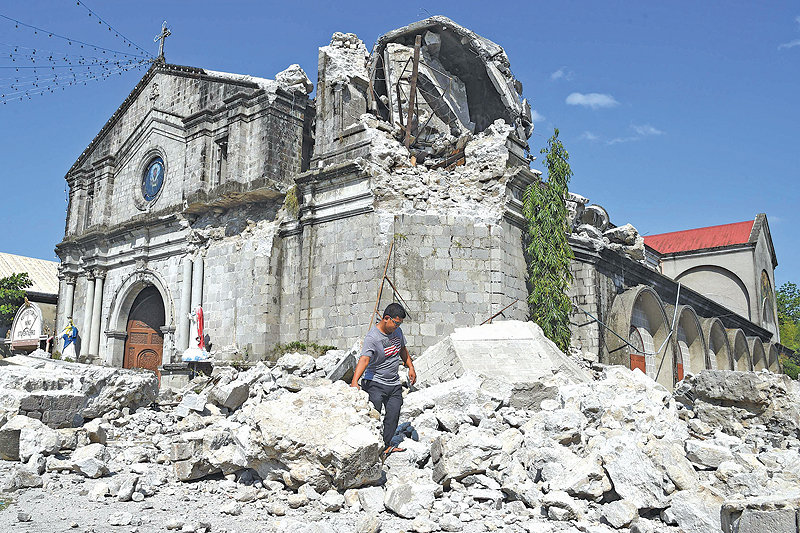PORAC: Philippine rescuers raced yesterday to reach some two dozen people still feared buried under a building near Manila that collapsed a day earlier in a deadly earthquake, as a powerful second tremor hit the nation. The US Geological Survey put the second quake-on the central island of Samar-at 6.4 magnitude, stronger than the one that wrought significant damage Monday near the capital in the north.


The latest quake sent terrified locals fleeing into the streets, with the authorities reporting 10 injuries-mostly from falling objects and one person who panicked and injured a leg jumping off a building. "No one started crying, but of course some panicked because it was really strong," said Rey Estrobo, a supervisor at a hotel in Borongan town, near the epicenter. At the same time, the toll in Monday's quake rose to 16, with most of the fatalities in the worst-hit northern province of Pampanga, national disaster officials said.
More than 100 others were injured by falling rubble on Monday, including in Manila, according to police. However, initial reports indicated relatively minor destruction in Samar given the strength of Tuesday's quake, which could be down to differences in ground composition. "The damage is more pronounced if the houses and buildings are built on a foundation of soft soil," seismologist Myla Advincula told AFP, referring to Pampanga's soft sediment. "It enhances the shaking effect."
"We're thankful we avoided serious damage compared to Pampanga," regional civil defense chief Henry Torres said, adding damage in Samar was limited to road and building cracks, a collapsed church wall, and a brief power outage. Scores of rescuers in the northern town of Porac spent Tuesday using cranes and jackhammers to peel back the pancaked concrete structure of a four-storey market building where the Red Cross said 24 people were unaccounted for. "Every minute, every second is critical in this rescue," Cris Palcis, a volunteer rescue dog handler, told AFP. "Time is short for the people under the rubble so we have to be quick."
Pampanga Governor Lilia Pineda told journalists that rescuers could still hear at least one person trapped beneath the rubble, and were digging delicately to avoid accidentally crushing the survivor. Rogelio Pacelo was shopping with his wife and child when the market building collapsed around them, but incredibly they made it out, almost without a scratch. "I thought this only happens in movies. I thought that was the end of the world, it's our end," he told journalists. "I looked for a way out." The quake also damaged several centuries-old churches which were crowded with worshippers in recent days as the majority-Catholic Philippines marked the Easter holiday.
'Ring of Fire'
Porac-based Father Roland Moraleja said the 18th-century belfry of the Saint Catherine of Alexandria church collapsed in the quake. "It was the only part left from the old church," he told AFP. "The historical value is now gone, but we are hopeful that it will rise again." High-rise buildings in the capital swayed after the tremor struck Monday evening, leaving some with large cracks in their walls. Thousands of travelers were stranded after aviation authorities shut down the secondary Clark Airport, which is located on the site of the former US military installation that lies about an hour's drive north of the capital.
It was still closed on Tuesday as officials assessed the heavy damage to the terminal building and some cracking on the air traffic control tower. Monday's quake was centered on the town of Castillejos, about 100 kilometers northwest of Manila, local geologists said. Seismologists put the tremor at 6.3 initially, but subsequently downgraded it to a 6.1 magnitude. The Philippines is in the Pacific "Ring of Fire", an arc of intense seismic activity that stretches from quake-prone Japan through Southeast Asia and across the Pacific basin.- AFP

